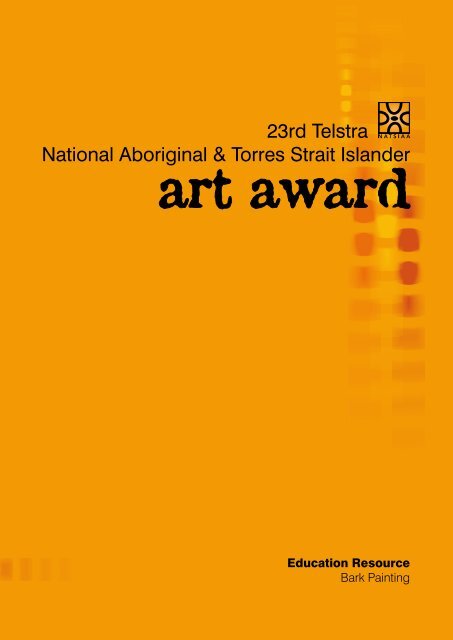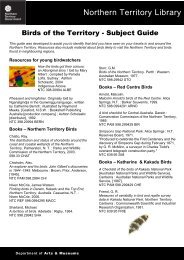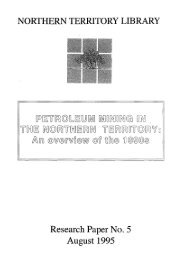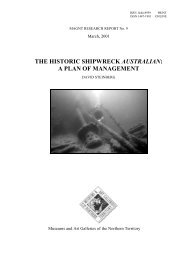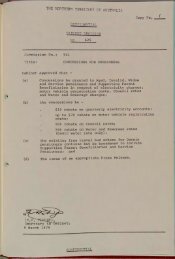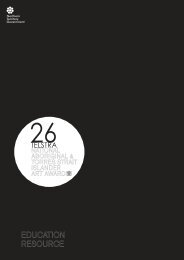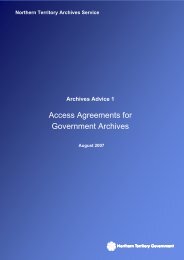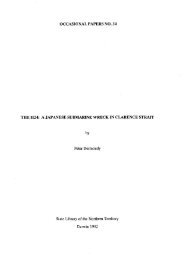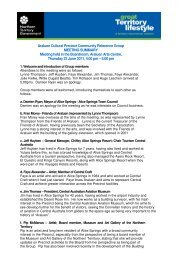Education Resource(small).indd - Department of Arts and Museums
Education Resource(small).indd - Department of Arts and Museums
Education Resource(small).indd - Department of Arts and Museums
Create successful ePaper yourself
Turn your PDF publications into a flip-book with our unique Google optimized e-Paper software.
23rd Telstra<br />
National Aboriginal & Torres Strait Isl<strong>and</strong>er<br />
<br />
<strong>Education</strong> <strong>Resource</strong><br />
Bark Painting
The Telstra National Aboriginal & Torres Strait Isl<strong>and</strong>er Art Award attracts hundreds <strong>of</strong> entries from<br />
established <strong>and</strong> up-<strong>and</strong>-coming Indigenous artists from which about one fi fth are preselected for<br />
the Award judging. The exhibition showcases classical <strong>and</strong> contemporary art styles <strong>and</strong> shows<br />
developments <strong>and</strong> experimentation taking place by artists utilising highly individual styles or those<br />
shared regionally eg Balgo artists, Lockart River <strong>and</strong> Arnhem L<strong>and</strong>.<br />
Indigenous Australian art is one <strong>of</strong> the oldest continuing art forms in the world. It is generally agreed<br />
that Indigenous Australians have been making art in this country for about 60 000 years. However<br />
the art has not remained static, but has shown a great resilience <strong>and</strong> ability to absorb techniques,<br />
mediums <strong>and</strong> styles as different cultures <strong>and</strong> groups have impacted upon Indigenous Australians.<br />
Many artists now utilise western techniques such as ceramics, printmaking, glassmaking,<br />
photography, cast metal sculpture <strong>and</strong> batik to name a few. The art produced is highly prized by<br />
collectors from all over the world <strong>and</strong> is considered fi ne art as well as unique cultural expression.<br />
But Indigenous art is also culturally signifi cant <strong>and</strong> is a way to express a variety <strong>of</strong> messages<br />
ranging from people’s identity, their relationship to Ancestral Beings <strong>and</strong> to the l<strong>and</strong>. It also provides<br />
commentary on actual events from the past <strong>and</strong> present <strong>and</strong> political messages concerning issues<br />
such as the Stolen Generations, Reconciliation, Native Title <strong>and</strong> Deaths in Custody.<br />
This Teacher <strong>Resource</strong> Kit explores themes using selected artworks from the 23rd Telstra National<br />
Aboriginal & Torres Strait Isl<strong>and</strong>er Art Award exhibition. These themes are Bark Painting; Totems;<br />
Fibrecraft <strong>and</strong> Urban Artists. Teachers <strong>and</strong> students are invited to extend the activities <strong>and</strong> artworks<br />
presented in this Kit <strong>and</strong> to build on the suggested activities <strong>and</strong> selected artworks.<br />
This Kit is also a companion for activities from previous Art Awards <strong>and</strong> Aboriginal art appearing on<br />
the Museum <strong>and</strong> Art Gallery <strong>of</strong> the Northern Territory’s website<br />
www.magnt.nt.gov.au
Bark paintings are used in closed <strong>and</strong> restricted ceremonies to represent <strong>and</strong> embody the presence<br />
<strong>and</strong> power <strong>of</strong> Ancestral characters <strong>and</strong> events. They are made in northern Arnhem L<strong>and</strong> <strong>and</strong> have<br />
also been made in Victoria <strong>and</strong> Tasmania.<br />
The bark used for bark paintings is cut from the stringybark tree (Eucalyptus tetrodonta). The bark is<br />
stripped from the tree in one sheet during the wet season when the sap is rising <strong>and</strong> the bark is pliant.<br />
It is fl attened by being dried out under logs or hot s<strong>and</strong>, or over hot coals.<br />
The red <strong>and</strong> yellow pigments used for the paintings are made from natural minerals called ochres.<br />
Crushed charcoal is used to make black paint <strong>and</strong> clay is used for white. Ochres are ground, mixed<br />
with glue (sap or egg were used before commercial glue became available) <strong>and</strong> water to make paint.<br />
The paint is applied with a brush that is sometimes made from human hair tied to a twig.<br />
In northern Arnhem L<strong>and</strong>, paintings on bark shelters are stylistically similar to rock shelter paintings<br />
from the region. They were used to illustrate stories which were told to young people during the long<br />
hours <strong>of</strong> the wet season when people were confi ned to the shelter.<br />
Missionaries <strong>and</strong> anthropologists started to collect these art forms <strong>and</strong> encouraged the production <strong>of</strong><br />
these bark paintings which they were able to sell <strong>and</strong> raise revenue for the missions. In Milingimbi,<br />
Reverend T T Webb encouraged bark painting from the late 1920s. At Yirrkala, Reverend W<br />
Chaseling encouraged the production <strong>of</strong> bark paintings for sale from 1935.<br />
In subsequent years dem<strong>and</strong> for the paintings grew <strong>and</strong> mission shops became their primary outlet.<br />
Today bark painting is an important industry particularly for artists in Arnhem L<strong>and</strong>, <strong>and</strong> art centres<br />
based in these communities or regions that conduct business on behalf <strong>and</strong> for the artists.<br />
In north-east Arnhem L<strong>and</strong> the bark painting is quite distinctive. These paintings are different to<br />
those <strong>of</strong> western Arnhem L<strong>and</strong> in that the background instead <strong>of</strong> being plain ochre consists <strong>of</strong> many<br />
varied sections <strong>of</strong> geometric patterns. The cross-hatching used on these paintings indicates the clan<br />
associations to the subjects. These patterns belong to particular clans <strong>and</strong> symbolise ancestral power.<br />
The paintings are <strong>of</strong>ten divided into segments by borderlines somewhat like a cartoon. Each <strong>of</strong> these<br />
segments illustrates a particular part <strong>of</strong> the story. In this way, artists can narrate as much or as little<br />
<strong>of</strong> their clan stories as they require. The composition identifi es relationships between the Ancestral<br />
beings <strong>and</strong> between the features <strong>of</strong> Ancestor created l<strong>and</strong>scape.<br />
In western Arnhem L<strong>and</strong> bark artists paint a variety <strong>of</strong> images similar to those found in rock art<br />
sites <strong>of</strong> the region. Mimi fi gures, rainbow serpents <strong>and</strong> other spirit beings are depicted on a plain<br />
background. Other common subjects include the X-ray images <strong>of</strong> animals painted onto a plain<br />
ochre background. Artists also incorporate cross-hatched designs known as rarrk which they use on<br />
paintings <strong>of</strong> Ancestral beings.
B<strong>and</strong>uk Marika<br />
Rulyapa<br />
Natural pigments on bark<br />
This miny’tji (sacred clan design) represents Rulyapa, the rough saltwater country between Nhulunbuy<br />
<strong>and</strong> the large isl<strong>and</strong> <strong>of</strong> Dhambaliya, ballooning up from the secret depths around the sacred rock<br />
Manhala, which can be a manifestation <strong>of</strong> Daymirri. Daymirri is the whale (or perhaps sea monster),<br />
that according to Rirratjingu <strong>and</strong> Djambarrpuyngu clan manikay (sacred song) pertains to the<br />
saltwater country close to Yirrkala. The dome-shaped rock Manhala exposes itself at the low tide<br />
above the rang (tide marks) bleached white, a patina <strong>of</strong> brine <strong>and</strong> weather.<br />
Manhala is one <strong>of</strong> many names given to the rock. Djambarrpuyngu <strong>and</strong> Rirratjingu clans have many<br />
‘deep’ names that are intoned by the ritual specialists at the culmination <strong>of</strong> appropriate ceremony.<br />
The sea surrounding the rock, its tidal movements, differing states <strong>and</strong> the effect it had on Yolngu<br />
visiting this site in ancestral times is all recorded in the sacred song as are all the totemic species<br />
<strong>of</strong> marine life that have these ancestral connections to the Rirratjingu <strong>and</strong> Djambarrpuyngu. Often<br />
painted in this design is Daymirri (whale), Balpa (rock cod), Djumbarr (red emperor), Darrpa (king<br />
brown snake) <strong>and</strong> Mutjalanydjal (dolphin). All <strong>of</strong> these things <strong>and</strong> all <strong>of</strong> their meanings are implied<br />
simply by the presence <strong>of</strong> the miny’tji for the water.<br />
It’s not just Manhala <strong>and</strong> the power associated with deep seated knowledge that makes this area<br />
both sacred <strong>and</strong> dangerous to those entering without authority. There are three other rocks in the<br />
area <strong>of</strong> similar qualities but these ones - Wakwakbuy, Mulnguwuy <strong>and</strong> Dharrpawuy are submerged.<br />
(Buku-Larrnggay Mulka Centre)
Keith Lapulung<br />
Untitled<br />
Natural pigments on bark<br />
This painting is by Keith Lapulung who has been assisted by his younger brother Djundu Djakala.<br />
It contains an important cultural link between two countries, which belong to the Djambarrpuyngu<br />
clan nation <strong>of</strong> north-east Arnhem L<strong>and</strong>. The two countries represented are Garrata (top layer) <strong>and</strong><br />
Ngurruyurrtjurr (bottom layer). The middle layer with the roundel depicts two salt water Rengitj (song<br />
cycles) classifi ed as the rulyapa <strong>and</strong> murrupu, ocean currents meeting together.<br />
The depiction <strong>of</strong> Garrata features the Mana or ancestral shark dreaming, gut-gut (ceremonial<br />
headb<strong>and</strong>) <strong>and</strong> a yininya or ceremonial spear belonging to the Yirritja peoples. The ‘U’ shaped object<br />
inside the shark is the djukurru (fat) which has great cultural signifi cance. Just beneath is the warrngul<br />
or stingray barbed ceremonial spear belonging to Dhuwa people <strong>of</strong> the Dhamalamirr clan.<br />
The two Namal (stingray) represent the importance <strong>of</strong> the cultural connection between the shark,<br />
the Djambarrpuyngu people <strong>of</strong> the Dhamalamirr clan whose nation is at Garrata. The rarrk (crosshatching)<br />
symbolises the current <strong>of</strong> the two waters meeting <strong>and</strong> forming one current. The roundel<br />
itself represents the Garma (meeting place for ceremony). An assembly area <strong>and</strong> common ground<br />
for both Djambarrpuyngu clan nations, the Dhamalamirr clan <strong>and</strong> Dhabunba clan.<br />
The bottom layer <strong>of</strong> the painting depicts the Mutuldja Nyapili (mythical king brown snakes) who rest<br />
at Ngurruyurrtjurr. Two bawung (native yams) in fl ower are depicted inside, again emphasising the<br />
importance <strong>of</strong> the country. In the centre is a barala (s<strong>and</strong> bar) which the snakes rest under. Two<br />
warrarri (ceremonial spears) belonging to the Dhabunba clan are depicted on the outer edges.<br />
(Milingimbi <strong>Arts</strong> <strong>and</strong> Craft)
Paul Nabulumo Namarinjmak<br />
Creek at Kubumi<br />
Natural pigments on bark<br />
This painting refers to a creek at Kubumi near the outstation Yikarrarkkal where Paul Nabulumo<br />
Namarinjmak lives with his family <strong>and</strong> father Mick Kubarkku. This creek is associated with Ngalyod<br />
(the rainbow serpent).<br />
The rainbow serpent is a powerful mythological fi gure for all Aboriginal people throughout Australia.<br />
Characteristics <strong>of</strong> the rainbow serpent vary greatly from group to group <strong>and</strong> also depending on the<br />
site. Often viewed as a female generative fi gure, the rainbow serpent can sometimes also be male.<br />
She has both powers <strong>of</strong> creation <strong>and</strong> destruction <strong>and</strong> is most strongly associated with rain monsoon<br />
seasons <strong>and</strong> <strong>of</strong> course the colour seen in rainbows which arc across the sky like a giant serpent.<br />
For Aboriginal people in northern Australia the rainbow serpent is said to be active during the wet<br />
season. Known as Ngalyod in the Kuninjku language <strong>of</strong> western central Arnhem L<strong>and</strong>, the rainbow<br />
serpent is mostly associated with bodies <strong>of</strong> water such as billabongs, creeks, rivers <strong>and</strong> waterfalls<br />
where she (Ngalyod) resides. Therefore she is responsible for the production <strong>of</strong> most water plants<br />
such as water lilies, water vines, algae <strong>and</strong> palms, which grow near water. The roar <strong>of</strong> waterfalls in the<br />
escarpment country is said to be her voice. Large holes in stony banks <strong>of</strong> rivers <strong>and</strong> cliff faces are<br />
said to be her tracks. She is held in awe because <strong>of</strong> her apparent ability to renew her life by shedding<br />
her skin <strong>and</strong> emerging anew.<br />
Aboriginal myths about the rainbow serpent <strong>of</strong>ten describe her as a fearful creature that swallows<br />
humans only to regurgitate them, transformed by her blood. The white clay used by artists to create<br />
the brilliant white for bark paintings, body decoration <strong>and</strong> in the past, rock art, is said to be the faeces<br />
<strong>of</strong> the rainbow serpent.<br />
Aboriginal people today respect <strong>and</strong> take care <strong>of</strong> sacred areas where the rainbow serpent is said to<br />
reside. Often certain activities are forbidden at these places for fear that the wrath <strong>of</strong> the great snake<br />
will cause sickness, accidents <strong>and</strong> even tempests. This is not always the case however <strong>and</strong> there are<br />
many rainbows.<br />
(Maningrida <strong>Arts</strong> <strong>and</strong> Culture)
Years T-7<br />
At the Exhibition<br />
1. What colours are used in the featured bark paintings<br />
2. In the painting called Creek at Kubumi, what things can you learn about the Rainbow Serpent<br />
3. Which bark painting do you like <strong>and</strong> why<br />
At School<br />
1. Use paints that are close to the ochres used in Aboriginal bark paintings. On a piece <strong>of</strong><br />
cardboard paint you own cross-hatched painting <strong>of</strong> your favourite animal.<br />
2. Experiment at school using different natural items such as soil, ash, rock etc to make earth<br />
colours by grinding them <strong>and</strong> adding water or glue.<br />
3. Stage your own bark painting exhibition by choosing an animal to paint. Write the story about<br />
your animal <strong>and</strong> place your paining <strong>and</strong> text panel around the classroom.<br />
Years 8-10<br />
At the Exhibition<br />
1. Make a summary <strong>of</strong> the explanations given by the featured artists about their bark paintings.<br />
2. Compare <strong>and</strong> contrast the techniques, colours, forms <strong>and</strong> patterning <strong>of</strong> these three artworks.<br />
3. Can you fi nd the different symbols used by each featured artist to depict natural forms in<br />
their paintings<br />
At School<br />
1. Design a symbol with more than one meaning. As a class discuss each others’ symbols.<br />
2. Divide a piece <strong>of</strong> paper in three sections <strong>and</strong> using the cross-hatching method <strong>of</strong> painting<br />
produce three cartoons about your life so far.<br />
3. Research the importance <strong>of</strong> bark painting to people in Arnhem L<strong>and</strong>. List the differences<br />
between western Arnhem L<strong>and</strong> bark paintings <strong>and</strong> those from north-eastern Arnhem L<strong>and</strong>.
23rd Telstra<br />
National Aboriginal & Torres Strait Isl<strong>and</strong>er<br />
<br />
<strong>Education</strong> <strong>Resource</strong><br />
Totems
Some works <strong>of</strong> Indigenous art are accessible to ‘white eyes’; however others aren’t <strong>and</strong> are diffi cult<br />
to place. The hollow log bone c<strong>of</strong>fi n is one <strong>of</strong> the latter. During the sixties, when Aboriginal art<br />
was ‘discovered’, installations <strong>of</strong> so-called ‘totem poles’ were popular, though rarely placed in the<br />
prominent places which they deserved.<br />
These ‘totems’ have signifi cance within their community <strong>and</strong> are an important part <strong>of</strong> the mortuary<br />
ceremonies which have occurred for thous<strong>and</strong>s <strong>of</strong> years. In north-eastern Arnhem L<strong>and</strong>, the Yolngu<br />
people continue many age old ceremonies <strong>and</strong> rituals. One <strong>of</strong> these is the Hollow Log or Bone<br />
C<strong>of</strong>fi n ceremony.<br />
When a person dies, the body is washed, painted with relevant totemic designs, sung over, mourned<br />
<strong>and</strong> placed on an burial platform. Some time later the bones <strong>of</strong> the deceased are recovered <strong>and</strong><br />
distributed to relatives in a <strong>small</strong> ceremony. After a period, this may be years, the relatives h<strong>and</strong> over<br />
the bones to ceremonial leaders for them to hold a Hollow Log ceremony.<br />
A log hollowed out naturally by termites is found, cleaned <strong>and</strong> painted with relevant designs, like the<br />
body, amidst singing <strong>and</strong> dancing in a special ceremony for those completing the ritual. The bones<br />
are cleaned, painted with red ochre <strong>and</strong> placed in the log during special dances. When a set series<br />
<strong>of</strong> songs <strong>and</strong> dances has been completed, the log is then carried <strong>and</strong> danced into the main public<br />
camp <strong>and</strong> stood upright. It is then left.<br />
Full-size versions minus the bones are made <strong>and</strong> sold today as sculptures. These works are art<br />
pieces in their own right<br />
The Tiwi people <strong>of</strong> Bathurst <strong>and</strong> Melville Isl<strong>and</strong>s also follow a mortuary tradition which involves burial<br />
poles. Found around the graves <strong>of</strong> Tiwi people, the poles known as pukumani poles, also called<br />
Tutini, can be as high as 4m. They are usually made from ironwood trees <strong>and</strong> painted with elaborate<br />
designs representing the deceased.<br />
The Pukumani Mortuary Ceremony celebrates the life <strong>of</strong> a person who has died <strong>and</strong> ensures their<br />
spirit’s safe journey to the l<strong>and</strong> <strong>of</strong> the dead. The ceremony involves making large carved decorated<br />
poles which may take weeks. Techniques utilised during the making <strong>of</strong> the poles include painting<br />
patterns using ochres, singing <strong>and</strong> cutting ‘windows’ into the poles.<br />
During the ceremony, dancers will make payments to the carvers as a sign <strong>of</strong> their appreciation.<br />
Artists are encouraged to be original in their designs <strong>and</strong> take great pleasure in the fi nal appearance<br />
<strong>of</strong> the carvings. Bark baskets called Tunga, are placed over the top <strong>of</strong> the posts to signify the end <strong>of</strong><br />
the food obligations to the deceased person.<br />
While they still carve stylised pukumani poles for use in ceremony, they also produce fi gurative<br />
carvings <strong>of</strong> birds <strong>and</strong> human sculptures for sale.
Baluka Maymuru<br />
Dhak<strong>and</strong>jali<br />
Natural pigments on wood<br />
These Dhak<strong>and</strong>jali are memorial poles for Manggalili clan people.<br />
The poles each have two jaws. One <strong>of</strong> these is shorter than the other. There are deep meanings<br />
behind this symbolism that distinguish this log as a Manggalili vessel. It is generally conceived that<br />
the larrakitj used by Yolngu are an ancestral skin or body for bones that are essentially components<br />
<strong>of</strong> the Creation. Once the fl esh has dissolved the unhelpful emanations dispersed <strong>and</strong> the elemental<br />
spirit <strong>of</strong> the deceased has merged with its clan’s reservoir <strong>of</strong> souls the bones are ready to wear a new<br />
protection. The Manggalili place their bones inside a creature that is not known to non-Yolngu. This<br />
clan <strong>and</strong> the Wangurri recognise this creature which sometimes manifest as a log <strong>and</strong> other times<br />
as Mulmirri (a sea monster). This log/being can traverse the journey <strong>of</strong> the spirit through the various<br />
states <strong>of</strong> water depicted. Only a log imbued with mangrove worms that died when the log passed<br />
into freshwater causes the breakage which distinguishes Manggalili identity.
The references to Manggalili sites, ancestral forces <strong>and</strong> ceremony are so dense that they are hard to<br />
outline here. One <strong>of</strong> the panels <strong>of</strong> this hollow log is a depiction <strong>of</strong> Yingapungapu - the elliptical shape.<br />
It relates to the drowning death <strong>of</strong> canoe hunters whose spirits transfer to the Milky Way.<br />
The Yingapungapu is a low relief s<strong>and</strong> sculpture used in the context <strong>of</strong> mortuary for the Yirritja clans<br />
<strong>of</strong> Manggalili, Madarrpa <strong>and</strong> Dhalwangu. Its primary traditional function is to keep the contamination<br />
<strong>of</strong> death within the confi nes <strong>of</strong> the sculpture. Placement <strong>of</strong> the deceased within the Yingapungapu<br />
on the associated clan l<strong>and</strong> in days before contact had been reserved originally for the Creator<br />
Ancestors. In these areas <strong>and</strong> by way <strong>of</strong> permanence for perpetuity, Yingapungapu sites denoted<br />
indisputable l<strong>and</strong> ownership.<br />
Baluka has painted Yingapungapu at Djarrakpi <strong>and</strong> icons that have reference to the events <strong>of</strong> the<br />
original Manggalili deaths. It is a saltwater image therefore having reference to Nyapalingu (Creator<br />
Woman) <strong>and</strong> her involvement as a mother earth fi gure when it comes to mortuary. The ‘X’ shape in<br />
this pole is also a manifestation <strong>of</strong> Nyapalingu.<br />
The sacred design throughout is <strong>of</strong> the Manggalili clan, denoting Djarrakpi. The wavy lines have<br />
reference to saltwater <strong>and</strong> turtle tracks in the s<strong>and</strong> dunes. Gunyan the ghost s<strong>and</strong> crab has its hole in<br />
the same s<strong>and</strong>. Out <strong>of</strong> his hole the crab seeks carrion that has a cleansing effect on the beach <strong>and</strong><br />
is thus a metaphor in that the body is cleansed in preparation for fi nal rites outside the Yingapungapu.<br />
Often this is painted by Manggalili in placing the fi sh caught by Ancestral Hunters - Lalu or Yambirrku<br />
the parrot fi sh within the Yingapungapu to be utilised as an area for food scraps, thus taking away<br />
some <strong>of</strong> the power illustrated here for the main event. The round ‘stations’ can be seen as holes<br />
within the Yingapungapu used to bury food remains <strong>and</strong>/or places where specifi c relatives <strong>of</strong> the<br />
deceased administer mortuary rites.<br />
Nguykal (Greater Trevally or Turrum) is adorned with the clan miny’tji (design) <strong>of</strong> the freshwater in the<br />
Wayawu River that contains the corm <strong>of</strong> the yoku (water lily). This indicates the embodiment <strong>of</strong> the<br />
feminine, the yoku the yothu or child within. Ngukal follows out <strong>of</strong> the freshwater in the panel below. This<br />
is also depicted in the anvil shapes (one black, one white) which fl ow back to the Yingapungapu above.<br />
Nguykal from the waters <strong>of</strong> the sea (<strong>of</strong> Djarrakpi) venture up to this point in the Wayawu River. They<br />
are depicted here carrying the miny’tji <strong>of</strong> the saltwater country <strong>of</strong> Djarrakpi to mix with the fresh. There<br />
is held by Yolngu mythology <strong>of</strong> ancestral hunting <strong>of</strong> Nguykal from the rock, revered as sacred here<br />
also as this water source is a font <strong>of</strong> Manggalili soul.<br />
One pole has a ‘fertile’ area where the freshwater coming down meets the natural dry season barriers<br />
<strong>of</strong> s<strong>and</strong> bars that halt the tidal surge. It is known as maywundji. This is where the lightning serpent<br />
Gayitj stays. The freshwater is running a new season has begun <strong>and</strong> the wet is imminent. Gayitj on<br />
tasting the infl ux <strong>of</strong> freshwater coming down from the sacred l<strong>and</strong>s st<strong>and</strong>s up on its tail from its lorr<br />
(hole) to herald the event to kin by spitting lightning into the skies. At the top <strong>of</strong> that pole the dead<br />
<strong>and</strong> fallen leaves <strong>of</strong> the mangrove called motu gather on the surface <strong>of</strong> the serpent’s waterhole,<br />
banking up at the barrage to be fi nally spilled out to sea. A metaphor <strong>of</strong> the yothu (child) being<br />
released <strong>and</strong> the procreative qualities <strong>of</strong> these sacred waters. The ‘X’-shapes can also be seen as<br />
feminine wet season cloud.<br />
A cycle <strong>of</strong> events is complete. The sacred songs tell <strong>of</strong> the rains <strong>and</strong> freshwaters travelling through<br />
the l<strong>and</strong>s to meet the sea to then be mixed on the shore by the action <strong>of</strong> in <strong>and</strong> out tides before being<br />
taken up with the currents. Out at sea they will be further imbued with the Ancestral powers at sacred<br />
sites before being taken up by the forces <strong>of</strong> the storm clouds that rain all the way back across the sea<br />
to the l<strong>and</strong> <strong>and</strong> the rivers that run back to sea.<br />
(Buku-Larrnggay Mulka Centre)
Ian Waldron<br />
Bloodwood Totem from Kurtijar Country in the Gulf <strong>of</strong> Carpentaria<br />
Synthetic polymer paint on canvas<br />
“The Bloodwood is a totem <strong>of</strong> Kurtijar people, from my Aboriginal ancestors down through to me - an<br />
urban Aborigine. My artistic interpretation <strong>of</strong> this tree is fl oated on the canvas to remind me <strong>of</strong> our<br />
close connection to the l<strong>and</strong>.<br />
The fl oating <strong>of</strong> the trees represents the transition <strong>of</strong> the trees from the l<strong>and</strong> to spiritual form, then to<br />
me <strong>and</strong> back to the l<strong>and</strong>. To me the totem parallels the Christian belief <strong>of</strong> “from dust we come, to<br />
dust we return” <strong>and</strong> we must remember our spiritual connection to l<strong>and</strong>. Through artistic activity a<br />
man can communicate with his Dreamtime.”<br />
(Ian Waldron)
Irenie Ngalinba<br />
Lorrkon<br />
Natural pigments on stringybark<br />
The Lorrkon or bone log c<strong>of</strong>fi n ceremony was the fi nal ceremony in a sequence <strong>of</strong> mortuary rituals<br />
celebrated by the people <strong>of</strong> Arnhem L<strong>and</strong>. This ceremony involves the placing <strong>of</strong> the deceased’s<br />
bones into a hollow log which was decorated with painted clan designs <strong>and</strong> ceremonially placed into<br />
the ground where it remained until it slowly decayed over many years.<br />
The log is made from a termite hollowed stringybark tree (Eucalyptus tetradonta) <strong>and</strong> is decorated<br />
with totemic emblems.<br />
The western Arnhem L<strong>and</strong> version <strong>of</strong> the Lorrkon ceremony involves the singing <strong>of</strong> sacred songs to<br />
the accompaniment <strong>of</strong> karlikarli, a pair <strong>of</strong> sacred boomerangs used as rhythm instruments.<br />
During the fi nal evening <strong>of</strong> the ceremony, dancers decorate themselves with kapok down or today<br />
cotton wool <strong>and</strong> conduct much <strong>of</strong> the fi nal segments <strong>of</strong> the ceremony in the secrecy <strong>of</strong> a restricted<br />
men’s camp. The complete ceremony may stretch over a period <strong>of</strong> two weeks but on the last night<br />
the bones <strong>of</strong> the deceased which have been kept in a bark container or today wrapped in cloth <strong>and</strong><br />
kept in a suitcase are taken out then painted with red ochre <strong>and</strong> placed inside the hollow log. This<br />
ceremony may take place many years after the person has died.<br />
At fi rst light on the fi nal morning <strong>of</strong> the Lorrkon ceremony, the men appear coming out <strong>of</strong> their secret<br />
bush camp carrying the pole towards the women’s camp. The two groups call to each other using<br />
distinct ceremonial calls. The women have prepared a hole for the pole to be placed into <strong>and</strong> when it<br />
is stood upright, women in particular kinship relationships to the deceased dance around the pole in a<br />
jumping/shuffl ing motion. The Lorrkon is then <strong>of</strong>ten covered with a tarpaulin <strong>and</strong> left to slowly decay.<br />
(Maningrida <strong>Arts</strong> <strong>and</strong> Culture)
John Martin Tipungwuti<br />
Pukumani Pole “Tutini”<br />
Natural pigments on Ironwood<br />
The Pukumani ceremony is the culmination <strong>of</strong> ritual mourning for a deceased person. Several months<br />
after burial the family commission in-laws <strong>of</strong> the deceased to carve <strong>and</strong> decorate elaborate tutini.<br />
These are then placed at the gravesite during an elaborate performance <strong>of</strong> song <strong>and</strong> dance, tunga<br />
(bark bags) are placed upside down on top <strong>of</strong> the poles to signify the end <strong>of</strong> life. These sculpturally<br />
beautiful ‘artworks’ are left to the elements returning to the bush from which they are made.<br />
Traditionally Tiwi use the bloodwood tree for tutini but cured ironwood is the preferred timber for<br />
commercial carvings thanks to its durability. Current practice <strong>of</strong> carving Pukumani poles is an<br />
expression <strong>of</strong> the artist’s cultural heritage through contemporary art. They are created as an artistic<br />
form <strong>of</strong> expression to be viewed <strong>and</strong> appreciated by a broader public with the intention to maintain<br />
<strong>and</strong> share Tiwi cultural knowledge.<br />
Tutini carved with a pronged or forked apex represent the fi ght between Purukuparli <strong>and</strong> his brother<br />
Taparra the moon man. Diamond <strong>and</strong> curved shapes are a female embodiment, but each pole<br />
represents all <strong>and</strong> everything that is Tiwi culture.<br />
(Jilamara <strong>Arts</strong> & Crafts Association)
Years T-7<br />
At the Exhibition<br />
1. Find the totems featured <strong>and</strong> write each artist’s name <strong>and</strong> where each artist lives. Can you fi nd<br />
the different names given by each artist for their totem<br />
2. Describe what the three totems featured are made from. Choose a symbol from each, copy it<br />
<strong>and</strong> then write what you think it is.<br />
3. Can you fi nd any other totems in the Art Award<br />
At School<br />
1. Using butcher’s paper cut out the shape <strong>of</strong> either a Pukumani pole or Log C<strong>of</strong>fi n, making each<br />
pole at least one metre in height. Use designs or symbols to decorate your totem pole <strong>and</strong><br />
display them around the classroom.<br />
2. Using toilet rolls or similar cardboard cylinders paint it showing your favourite animal. Place<br />
some messages, drawings or photos that are special to you in the cylinder. Display these in your<br />
classroom or the library.<br />
3. Research ceremonies that are used in other cultures, ancient <strong>and</strong> present day that deal with<br />
laying a person to rest after they have passed away.<br />
Years 8-10<br />
At the Exhibition<br />
1. Find the totem poles selected in this section. Choose one <strong>of</strong> them <strong>and</strong> write a newspaper story<br />
about the artwork <strong>and</strong> the artist.<br />
2. Compare <strong>and</strong> contrast the three featured totems, starting with the artist’s name <strong>and</strong> location.<br />
What makes each <strong>of</strong> these totems different <strong>and</strong> what similarities do they have<br />
3. Make a rough sketch <strong>of</strong> your favourite totem pole so that you can recreate it at school <strong>and</strong> add<br />
this to your newspaper story.<br />
At School<br />
1. Using blocks <strong>of</strong> balsa wood carve a totem pole <strong>and</strong> decorate it to show the place where you live<br />
<strong>and</strong> the place where your parents lived as children.<br />
2. Research different ceremonies carried out by different cultures relating to mortuary rites or death<br />
rites. Compare <strong>and</strong> contrast your fi ndings as a classroom activity.<br />
3. Research “The Aboriginal Memorial” produced in 1998 <strong>and</strong> featured at the National Gallery <strong>of</strong><br />
Australia. Where was this artwork created <strong>and</strong> why is it signifi cant as a piece <strong>of</strong> Australian art
23rd Telstra<br />
National Aboriginal & Torres Strait Isl<strong>and</strong>er<br />
<br />
<strong>Education</strong> <strong>Resource</strong><br />
Fibrecraft
Fibre plays an important role in the life <strong>of</strong> Indigenous people. The diverse range <strong>of</strong> techniques<br />
includes coiling, twining <strong>and</strong> looping. Plant fi bre is the most common material used to make a<br />
diverse range <strong>of</strong> functional items. The objects produced are signifi cant in practical <strong>and</strong> spiritual ways.<br />
Fibre objects are directly connected with the Ancestral Beings.<br />
The age old practice <strong>of</strong> weaving bags, baskets <strong>and</strong> mats from the leaves <strong>of</strong> the P<strong>and</strong>anus <strong>and</strong> the<br />
bark <strong>of</strong> the Kurrajong continues today. Producing the magnifi cent weavings is labour intensive <strong>and</strong><br />
involves a number <strong>of</strong> steps. This is almost always done by women in groups.<br />
The younger generation, taught the skills <strong>of</strong> fi brecraft by elders, also learn about the natural<br />
l<strong>and</strong>scape <strong>and</strong> the local <strong>and</strong> seasonal availability <strong>of</strong> materials. Weaving time is also a sharing time for<br />
stories <strong>and</strong> cultural knowledge.<br />
Patterns on baskets can be changed using different textures but usually they are achieved by<br />
changing colour. Women from western Arnhem L<strong>and</strong> use combinations <strong>of</strong> different materials,<br />
technique <strong>and</strong> colour to produce their range <strong>of</strong> baskets. In older baskets the patterning was achieved<br />
by painting ochres on to the fi bres <strong>and</strong> incorporating feathers into the weaving <strong>of</strong> the basket <strong>of</strong>ten<br />
resulting in geometric or fi gurative patterns.<br />
With the coming <strong>of</strong> European settlers, commercial dyes were able to be used as the settlers<br />
brought containers that allowed boiling <strong>of</strong> mashed dye plants. In western Arnhem L<strong>and</strong> colours<br />
were achieved using different plants eg yellow was achieved by collecting the roots <strong>of</strong> Pognolobus<br />
reticulatus. The roots are washed, pounded or scraped <strong>and</strong> then added to water. The leaves <strong>of</strong> the<br />
plant, p<strong>and</strong>anus are added to the water once it has boiled.<br />
Until very recently in Maningrida, the fi bre craft produced by Aboriginal artists, both men <strong>and</strong> women,<br />
has generally been overlooked. From a western perspective fi bre was viewed as craft rather than art<br />
even though it plays an important role in ceremony <strong>and</strong> in daily life. Growing interest in fi bre work<br />
has stimulated innovation from twined dilly bags <strong>and</strong> the conical p<strong>and</strong>anus mats (associated with the<br />
Djang’kawu creator beings) to the fi sh traps usually made by men.<br />
The weavers <strong>of</strong> central Australia have a limited tradition <strong>of</strong> fi bre as the majority <strong>of</strong> items are made <strong>of</strong><br />
wood. However with the establishment <strong>of</strong> the Ernabella Missionary, spinning wool, weaving <strong>and</strong> rug<br />
making were introduced.<br />
In 1995 a new fi bre movement emerged, triggered by the basketry technique <strong>of</strong> coiling. The women<br />
have been highly innovative with the materials used <strong>and</strong> the objects produced resulting in a new<br />
genre <strong>of</strong> fi bre sculpture emerging.<br />
The winners <strong>of</strong> last year’s Telstra First Prize, the Blackstone Tjanpi Weavers created a life sized grass<br />
Toyota. The judges in making their decision commented, “Tjanpi Grass Toyota by the Blackstone<br />
Tjanpi Weavers is a wonderfully witty, well-crafted <strong>and</strong> relevant work. In one sense it takes us to the<br />
heart <strong>of</strong> community life <strong>and</strong> its tradition <strong>of</strong> weaving from grass that belongs to the women’s country.<br />
On the other h<strong>and</strong> this work not only recognizes but also celebrates the four-wheel drive as central to<br />
desert living for Aboriginal people.”
Nora Campbell<br />
Vivian<br />
Raffi a, wire, wool, feather<br />
“The art work is <strong>of</strong> a woman named Vivian. She has a Coolamon. Vivian is looking for bush tucker.<br />
For many years women <strong>of</strong> Tijikala would go out bush to collect bush tucker to feed the whole family.<br />
Vivian represents many Aboriginal women who work very hard to provide food for their families.<br />
Aboriginal women are very strong <strong>and</strong> very proud.”<br />
(Nora Campbell <strong>and</strong> Cora Meruntji)
Jill Nganjmirra<br />
Mat with Floral Design<br />
P<strong>and</strong>anus, natural dyes<br />
The fl oral design, ‘kunngobarn mannguy marnbuyindanj’ in Kunwinjku is a rare but beautiful motif used<br />
by the weavers situated in Gunbalanya <strong>and</strong> nearby outstations.<br />
It was created by Jill Nganjmirra who developed it as a decorative feature <strong>of</strong> coiled mats <strong>and</strong> baskets.<br />
This twined mat takes the design a step further utilising the rich natural dyes to defi ne each element <strong>of</strong><br />
the design.<br />
(Injalak <strong>Arts</strong> <strong>and</strong> Crafts)
Elizabeth Djakurrurr<br />
Untitled<br />
P<strong>and</strong>anus, natural dyes
Years T-7<br />
At the Exhibition<br />
1. Find the featured artworks in this section. Describe each one, how it has been made <strong>and</strong> what<br />
has each artist used to produce their artwork<br />
2. Do you think people would use these artworks If so, how would people use them<br />
3. For each <strong>of</strong> the artworks list the colours used. Do you think you know where each weaver would<br />
have started their work<br />
At School<br />
1. Use different materials: wool, string, cardboard, rope or raffi a to create a woven object. You<br />
many like to coil or stitch a basket, or weave a mate or make a doll.<br />
2. In class research how baskets are made in Arnhem L<strong>and</strong>. Make a fl ip chart to show how the<br />
weaving process starts eg collect the material etc.<br />
3. Bring a woven object to class <strong>and</strong> do a ‘show <strong>and</strong> tell’ about the item, its use <strong>and</strong> its importance<br />
to you.<br />
Years 8-10<br />
At the Exhibition<br />
1. Describe each <strong>of</strong> the featured woven objects. Do they all have a functional use<br />
2. Can you identify all the colours used in each woven object How do you think these colours<br />
have been achieved<br />
3. What do these three different woven objects tell us about Indigenous weavings<br />
At School<br />
1. Research the signifi cance <strong>of</strong> weaving in Arnhem L<strong>and</strong>. Create a booklet to show the process<br />
involved in weaving beginning with the collection <strong>of</strong> the material.<br />
2. Experiment with different dyes commercial <strong>and</strong> natural to see what colours can be achieved<br />
using white wool, string or raffi a or any other fi bre.<br />
3. Explore other types <strong>of</strong> fi brecraft methods practised eg tatting, knitting, crocheting, fi nger knitting,<br />
plaiting <strong>and</strong> macramé <strong>and</strong> try one <strong>of</strong> these methods to create a fi bre object.
23rd Telstra<br />
National Aboriginal & Torres Strait Isl<strong>and</strong>er<br />
<br />
<strong>Education</strong> <strong>Resource</strong><br />
Urban Indigenous Artists
Indigenous art takes on a different form when the artist is an urban-based Indigenous artist. They<br />
may use the same technique <strong>of</strong> cross-hatching or dots <strong>and</strong> circles, they may use classic shapes.<br />
However these artists are not necessarily painting the special Dreaming stories that only artists from<br />
a particular region can paint because it is their country. The urban artist <strong>of</strong>ten paints about the things<br />
that st<strong>and</strong> between them <strong>and</strong> the country that has been taken away from them.<br />
Djon Mundine writing in Aboriginal Art in the Public Eye states, “The problem <strong>of</strong> contemporary<br />
innovations versus classical Aboriginal art has vexed art historians since at least the turn <strong>of</strong> the<br />
century. This has happened in two ways: the refusal to see classical Aboriginal art (bark paintings <strong>and</strong><br />
sculpture, <strong>and</strong> ‘dot’ paintings) in a contemporary sense, <strong>and</strong> the refusal until the last ten years to see<br />
non-classical, so called ‘urban’ Aboriginal Art as true Aboriginal work”.<br />
Until recently, authenticity was equated with tradition <strong>and</strong> the value <strong>of</strong> the object lay in its expression<br />
<strong>of</strong> a time <strong>and</strong> a culture that has passed rather that in its relevance as a refl ection <strong>of</strong> contemporary<br />
circumstances. The ‘urban’ artist may sometimes use terms which are generic <strong>and</strong> regional to<br />
describe their Aboriginality eg ‘Murri’ in the north-east <strong>and</strong> ‘Koori’ in the south-east <strong>of</strong> Australia,<br />
‘Nunga’ in coastal South Australia <strong>and</strong> “Nyoongah’ in south-western Australia. Artists may further use<br />
a language group to show the country with which they identify.<br />
Urban artists live in those areas <strong>of</strong> the country where the initial impact <strong>of</strong> colonisation was most<br />
strongly felt. Many <strong>of</strong> them are self taught, though an increasing number have participated in formal<br />
training at art schools. Their work looks to Aboriginal sources for inspiration <strong>and</strong> is informed by<br />
Western art, <strong>and</strong> occasionally, other art traditions.<br />
The various styles evident from these artists represent social <strong>and</strong> political viewpoints eg the issues <strong>of</strong><br />
dispossession, broken families, ‘stolen’ children, <strong>and</strong> racism were strong themes explored by urban<br />
artists in the second half <strong>of</strong> the twentieth century.<br />
Urban Aboriginal artists are breaking through the barriers <strong>of</strong> prejudice to establish themselves as<br />
artists in their own right. Their work is at the leading edge <strong>of</strong> Australian art <strong>and</strong> refl ects perspectives<br />
on Australian society which previously had been rarely acknowledged.<br />
Urban artists have experimented in a wide variety <strong>of</strong> media <strong>and</strong> modes <strong>of</strong> expression - ranging from<br />
paintings, prints <strong>and</strong> pottery to photography, digital work <strong>and</strong> installations. While the attraction <strong>of</strong><br />
traditional work is strong, it must be acknowledged that other forms are just as legitimate as examples<br />
<strong>of</strong> Indigenous art, <strong>and</strong> certainly the artworks <strong>of</strong> ‘urban’ artists are gaining acceptance eg urban<br />
artist Richard Bell was the winner <strong>of</strong> the Telstra First Prize in 2003 with his work entitled, Scientia E<br />
Metaphysica (Bell’s Theorem).
Archie Moore<br />
Maltheism<br />
Paper<br />
“The work is made with paper, from a Bible. The passage is from Deuteronomy <strong>and</strong> within its text<br />
is the endorsement from God to Moses for invasion <strong>of</strong> other nations. It says that you have the right<br />
to invade, take all their resources, kill all the men (non-believers) <strong>and</strong> make no treaty with them.<br />
The church is modelled on one <strong>of</strong> the very fi rst churches built in Australia. I found this in a book <strong>of</strong><br />
early buildings in Australia <strong>and</strong> I made a plan <strong>of</strong> it <strong>and</strong> transferred it to paper to make the sculpture.<br />
The sculpture rises out <strong>of</strong> the Bible <strong>and</strong> is made <strong>of</strong> folds with no extra paper being added (glued or<br />
otherwise).<br />
I couldn’t help but think that the Christians on the fi rst fl eet must have had some <strong>of</strong> Deuteronomy’s<br />
sentiments in their minds as they l<strong>and</strong>ed, invaded <strong>and</strong> conquered. The right-wing contender for<br />
Prime Minister in Israel’s recent election also quoted segments <strong>of</strong> Deuteronomy in his campaign. I<br />
think it also echoes religious/cultural intolerance elsewhere in the world; it has a universal meaning,<br />
not only with Indigenous Australians. The innocuous paper sculpture <strong>of</strong> the church belies the true<br />
message/s that inhabit it.”<br />
(Archie Moore)
Tony Albert<br />
Race Invader<br />
Synthetic polymer paint on canvas<br />
Race Invader explores ideas about the human condition, as it relates to a constructed ‘National<br />
Identity’. This work was painted shortly before 26 January 2006: Australia Day, a day <strong>of</strong> celebration<br />
for many Australians, but also Invasion Day, a day that symbolises dispossession <strong>and</strong> death for many<br />
Aboriginal people.<br />
The work asks the viewer to think about cultural defi nitions that are bestowed upon people through<br />
the mass media <strong>and</strong> the jingoistic nature <strong>of</strong> the ‘Australian Identity’ construct. Using popular culture<br />
imagery to portray an alien invasion <strong>and</strong> a limited colour pallet <strong>of</strong> green <strong>and</strong> gold, Race Invader<br />
satirises the idea <strong>of</strong> Australia’s settlement.<br />
(Tony Albert)
Yhonnie Scarce<br />
‘Enee, Meanee, Minee, Mo’<br />
Glass <strong>and</strong> mixed media<br />
“As an Indigenous child growing up in a <strong>small</strong> town I <strong>of</strong>ten heard the rhyme ‘Enee, meanee, minee,<br />
mo…catch a nigga by the toe’ etc.<br />
It wasn’t until I grew older that I realised how derogatory this rhyme was to myself <strong>and</strong> other<br />
Indigenous Australians. So with this piece I have tried to encapsulate this feeling <strong>of</strong> entrapment by<br />
producing h<strong>and</strong> blown bush food that are indicative <strong>of</strong> Indigenous Australians <strong>and</strong> their/my culture.<br />
These pieces are held inside a glass jar with the British fl ag restricting any chance <strong>of</strong> escape, giving<br />
an impression <strong>of</strong> catching an insect.<br />
There is also the representation <strong>of</strong> how Indigenous Australians were forced from their homel<strong>and</strong>s <strong>and</strong><br />
contained in the one area, away from their l<strong>and</strong>, culture <strong>and</strong> family unit.”<br />
(Yhonnie Scarce)
Judy Watson<br />
a preponderance <strong>of</strong> aboriginal blood<br />
Etching<br />
“I was compelled to make this series <strong>of</strong> works after listening to a lecture by Loris Williams <strong>and</strong><br />
Margaret Reid at the University <strong>of</strong> Queensl<strong>and</strong> on Indigenous people <strong>and</strong> the Right to Vote in<br />
Queensl<strong>and</strong>. Along with other artists I had been commissioned by the State Library <strong>of</strong> Queensl<strong>and</strong> to<br />
produce an artist’s book celebrating the Queensl<strong>and</strong> Centenary <strong>of</strong> Women’s Suffrage <strong>and</strong> Forty Years<br />
<strong>of</strong> Aboriginal Suffrage. I had decided however, I didn’t want to do this project. I had a lot on my plate<br />
already with two young kids <strong>and</strong> other work related deadlines in front <strong>of</strong> me. But, when I heard Loris<br />
use the term ‘a preponderance <strong>of</strong> aboriginal blood’, I was in, <strong>and</strong> I knew what I was going to make the<br />
work about. I dedicated this artist’s book to Loris <strong>and</strong> I’m sorry she never got to see it completed.<br />
Loris sent me material from her lecture <strong>and</strong> Margaret Reid sent me copies <strong>of</strong> some <strong>of</strong> the original<br />
documents in the archives. It is this material, that is so potent <strong>and</strong> so oppressive, that is the work.<br />
Its heaviness dictates an era <strong>of</strong> constriction <strong>and</strong> control for all Aboriginal people caught within its<br />
web. My dedication goes not only to Loris <strong>and</strong> Margaret but to all those writers, artists, researchers,<br />
educators, <strong>and</strong> librarians etc who have helped to reveal the whitewash <strong>of</strong> our history.<br />
The matrilineal side <strong>of</strong> my family is Aboriginal; our country is in north west Queensl<strong>and</strong>. My father’s<br />
family have Scottish <strong>and</strong> English ancestry. I fi t somewhere in between, I am Indigenous <strong>and</strong> non<br />
Indigenous. I embody the notion <strong>of</strong> two cultural frameworks occupying the same cultural space.<br />
My Aboriginal Gr<strong>and</strong>mother, Grace Isaacson, was born on Riversleigh Station in north west<br />
Queensl<strong>and</strong> in 1912. This is an area important in the study <strong>of</strong> palaeontology, fossils. Not far from<br />
here is Lawn Hill Gorge, a beautiful place, lush with plenty <strong>of</strong> water, plant <strong>and</strong> animal life. In 1990 <strong>and</strong><br />
2001 I went on a trip to Riversleigh Station <strong>and</strong> Lawn Hill Gorge with some <strong>of</strong> my family. It wasn’t the<br />
fi rst time I’ve been there but to go back again is to see something new each time <strong>and</strong> is an affi rmation<br />
<strong>of</strong> identity, ancestral links <strong>and</strong> connection with country. Being with family, talking to my Gr<strong>and</strong>mother,<br />
absorbing her memories, gaining an insight into her life <strong>and</strong> the way she sees the l<strong>and</strong>, being shown<br />
bushfoods <strong>and</strong> sites is some <strong>of</strong> my major research as an Indigenous visual artist. The strength <strong>of</strong><br />
these experiences sustains me <strong>and</strong> is the touchstone for my work.<br />
When I see the sort <strong>of</strong> material I researched for this project I am outraged that my own family<br />
especially my wonderful Gr<strong>and</strong>mother, Grace Isaacson, were subjected to this sort <strong>of</strong> treatment <strong>and</strong><br />
classifi cation by the white authorities in this country. I view this material with a deep, personal hurt for<br />
my family <strong>and</strong> for all Aboriginal people.<br />
The work is in a way very simple. I present copies <strong>of</strong> the original documents, overlaying them with<br />
images <strong>of</strong> blood. The printing process is chine collé in which thin paper; in this case photocopies<br />
onto banana fi bre paper are backed with acid free glue, a rice paste. They are placed face down<br />
onto etching plates, rubbed with a dark red ink, a dampened sheet <strong>of</strong> white cotton rag paper is<br />
placed over the top <strong>and</strong> then fed through the printing press which is like an old clothes mangle,<br />
squashing the paper into the surface <strong>of</strong> the plate so that it can pull the ink out. The pressure adheres<br />
the sticky glue on the back <strong>of</strong> the thin sheet <strong>of</strong> paper so that it becomes a part <strong>of</strong> the heavier white<br />
paper, collaging them together.<br />
Because this material from the archives already has a latent power, I didn’t want to change this very<br />
much. Its leakage onto the printed page is enough. My background is as a printmaker, so it was a<br />
natural progression to work with this medium for the artist’s book.”<br />
(Judy Watson)
Years T-7<br />
At the Exhibition<br />
1. Choose one <strong>of</strong> the featured artworks. What is it made from What do you think the artist is trying<br />
to show us<br />
2. List each <strong>of</strong> the featured artworks <strong>and</strong> list the materials used to make it.<br />
3. Can you fi nd any other artwork made by an artist from an urban area Write their name, title <strong>of</strong><br />
their work <strong>and</strong> what the work is made from <strong>and</strong> their language group (if that is recorded).<br />
At School<br />
1. Archie Moore has chosen folded paper made from the pages <strong>of</strong> the Bible. He has chosen<br />
to sculpt a church out <strong>of</strong> paper. Choose some special paper from a magazine <strong>and</strong> follow<br />
instructions to make an origami paper sculpture.<br />
2. Tony Albert has chosen the boxing kangaroo; a symbol <strong>of</strong> Australia’s fi ghting spirit to create his<br />
work. Draw a number <strong>of</strong> other Australian symbols that you know.<br />
3. Make your own artwork about something that is special to you about where you live <strong>and</strong> what<br />
happens there.<br />
Years 8-10<br />
At the Exhibition<br />
1. Study each <strong>of</strong> these featured artworks. List the author’s name, the material used <strong>and</strong> a<br />
paragraph about what the artist is trying to convey to us.<br />
2. What symbols have been used in each <strong>of</strong> the featured artworks<br />
3. Choose one <strong>of</strong> the featured artworks <strong>and</strong> pr<strong>of</strong>i le it by discussing its subject matter, style,<br />
composition, medium <strong>and</strong> form.<br />
At School<br />
1. Think <strong>of</strong> a viewpoint that you hold. Create an artwork to express this. Write a text panel<br />
explaining your artwork <strong>and</strong> display it in the classroom or library.<br />
2. Research the various viewpoints expressed in these featured artworks. How is the way the artist<br />
chose to present their viewpoint important in conveying their viewpoint<br />
3. Make a list <strong>of</strong> the urban Indigenous artists practising in Australia today. You might like to<br />
consider Trevor Nickolls, Tracey M<strong>of</strong>fat, Judy Watson, Ian Abdulla, Danie Mellor, Ian Waldron,<br />
Richard Bell, Christian Thompson, Brenda L Cr<strong>of</strong>t, Avril Quaill, Lin Onus, Ellen Jose, Fiona Foley<br />
<strong>and</strong> Sally Morgan.
Bibliography<br />
Ronald M Berndt & Catherine H Berndt with John E Stanton, Aboriginal Australian Art: A Visual<br />
Perspective, Sydney, 1982,<br />
Djon Mundine, Two hundred burial poles: The Aboriginal Memorial, The Oxford Companion to<br />
Aboriginal Art <strong>and</strong> Culture – Sylvia Kleinert <strong>and</strong> Margo Neale, Oxford University Press, Australia, 2000,<br />
pp142 – 143<br />
Sylvia Kleinert. ed, Aboriginal Art in the Public Eye, an Art Monthly Australia Supplement, Canberra,<br />
1992-93<br />
Caruana, Wally, Aboriginal Art, Singapore, 1993<br />
Internet Sites<br />
http://www.didgeridoos.net.au/burial-c<strong>of</strong>fi n-hollow-log.html<br />
http://www.ingarnendi.samuseum.sa.gov.au/db/features/story.phpprimKeyPost=22<br />
http://learnline.cdu.edu.au/units/aht214/topend/diversity.html<br />
http://www.maningrida.com/mac/exh_cover.phpid=17<br />
http://www.aboriginalartonline.com/regions/urban.php<br />
http://www.yirrkalaprints.com/about.html<br />
http://www.samuseum.sa.gov.au/aacg/speakingl<strong>and</strong>/story18/18_story.htm<br />
The 23rd Telstra National Aboriginal & Torres Strait Isl<strong>and</strong>er Art Award is supported by the Visual <strong>Arts</strong> <strong>and</strong> Craft Strategy, an initiative <strong>of</strong> the<br />
Australian, State <strong>and</strong> Territory Governments.


